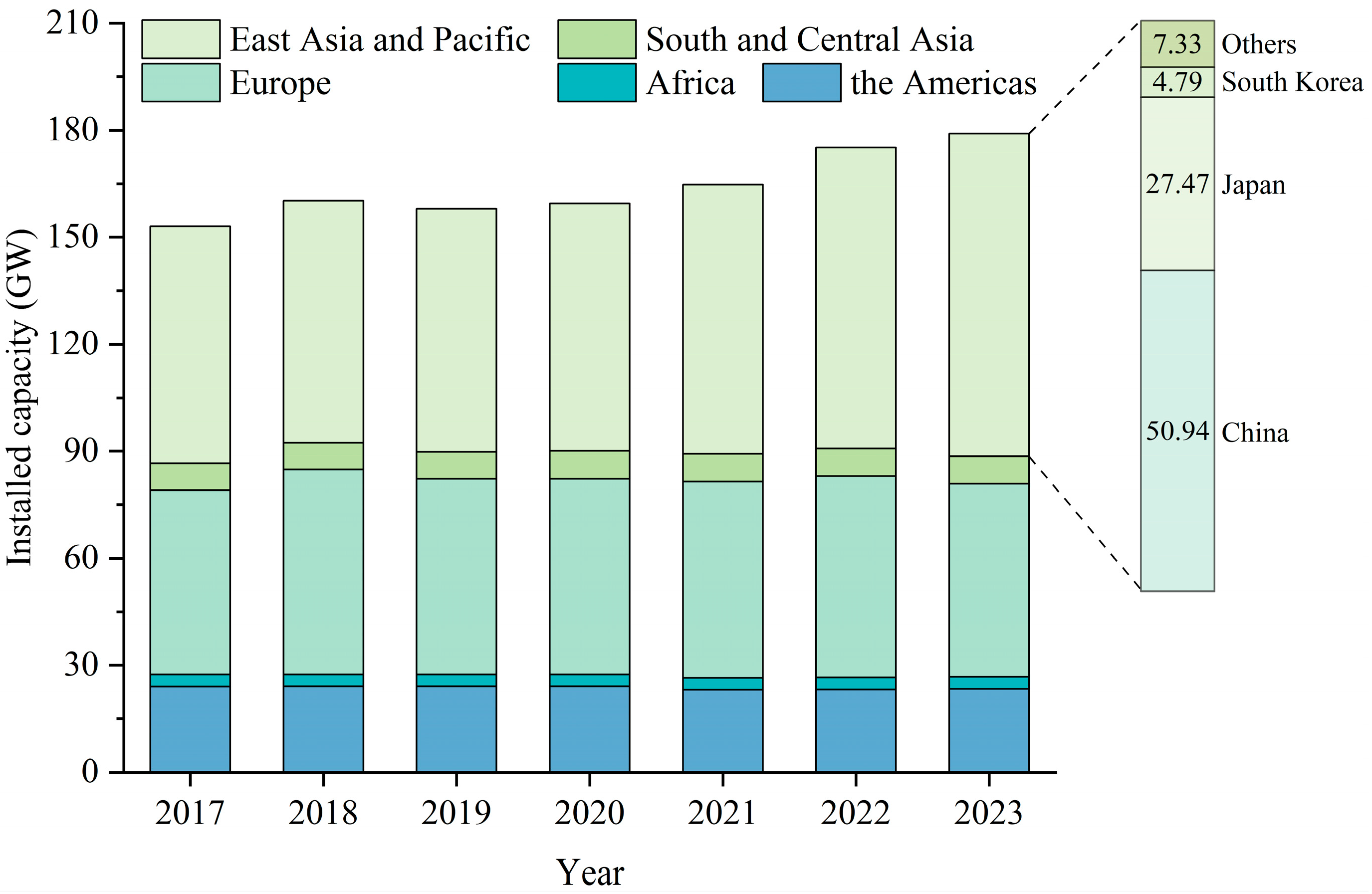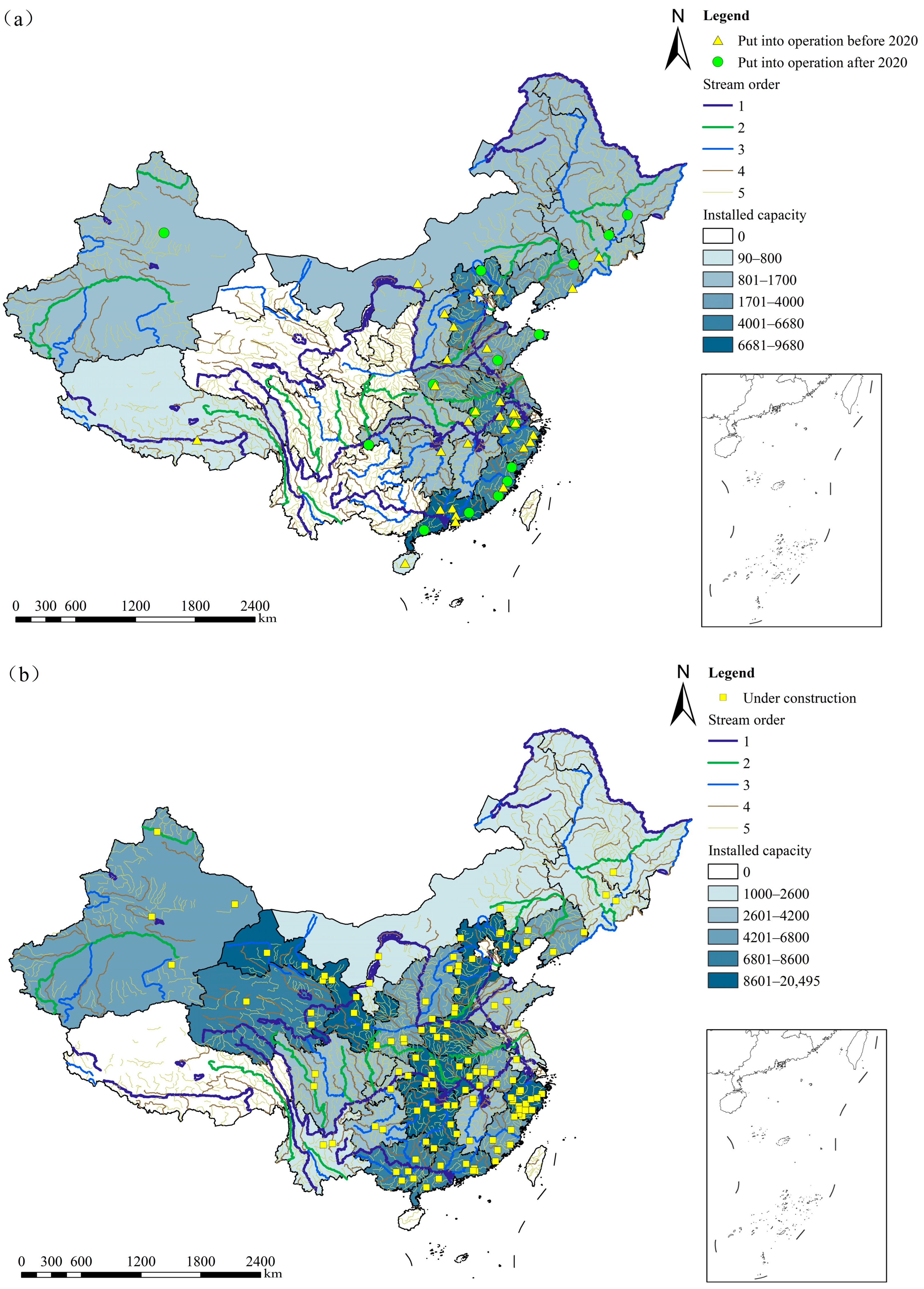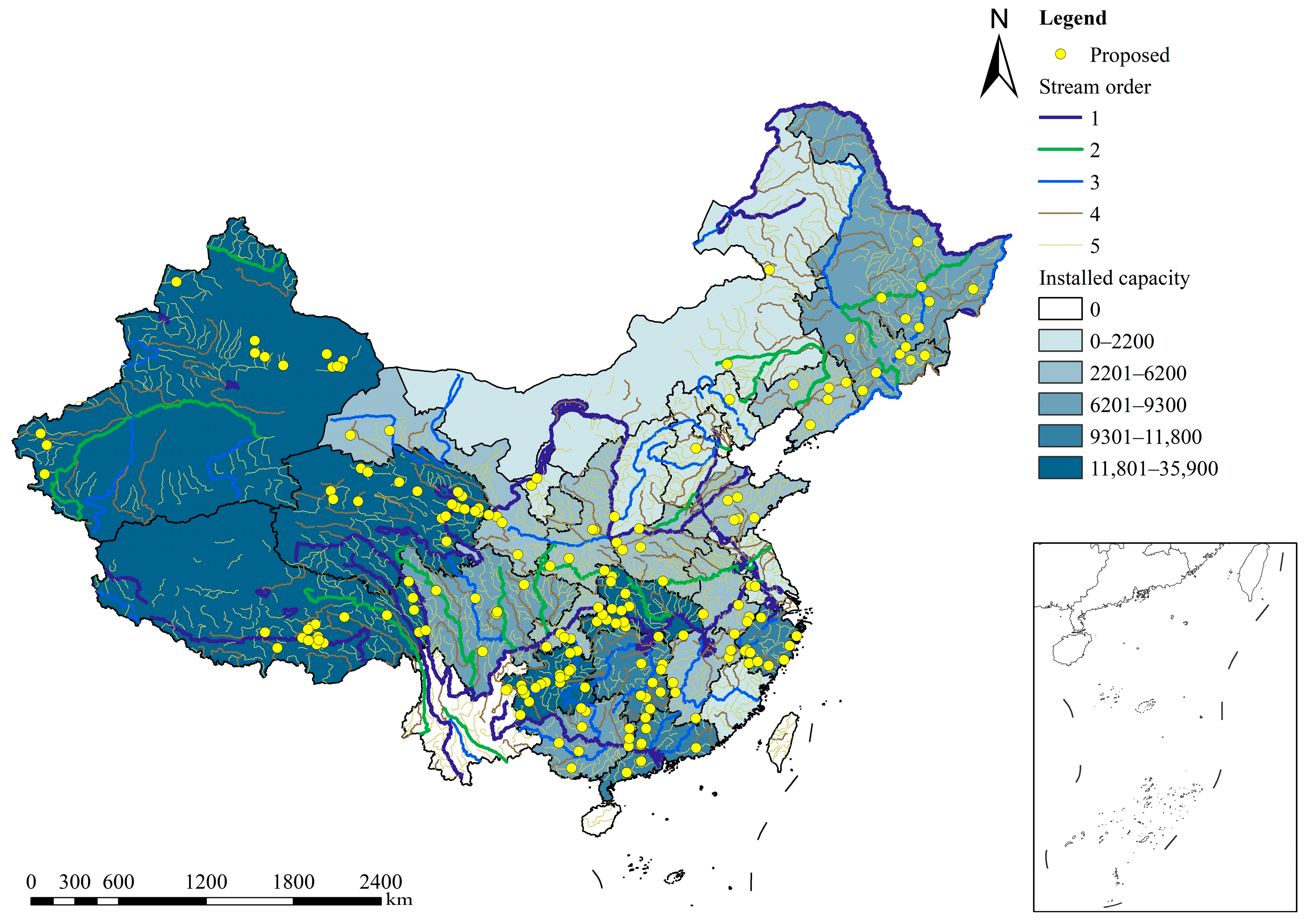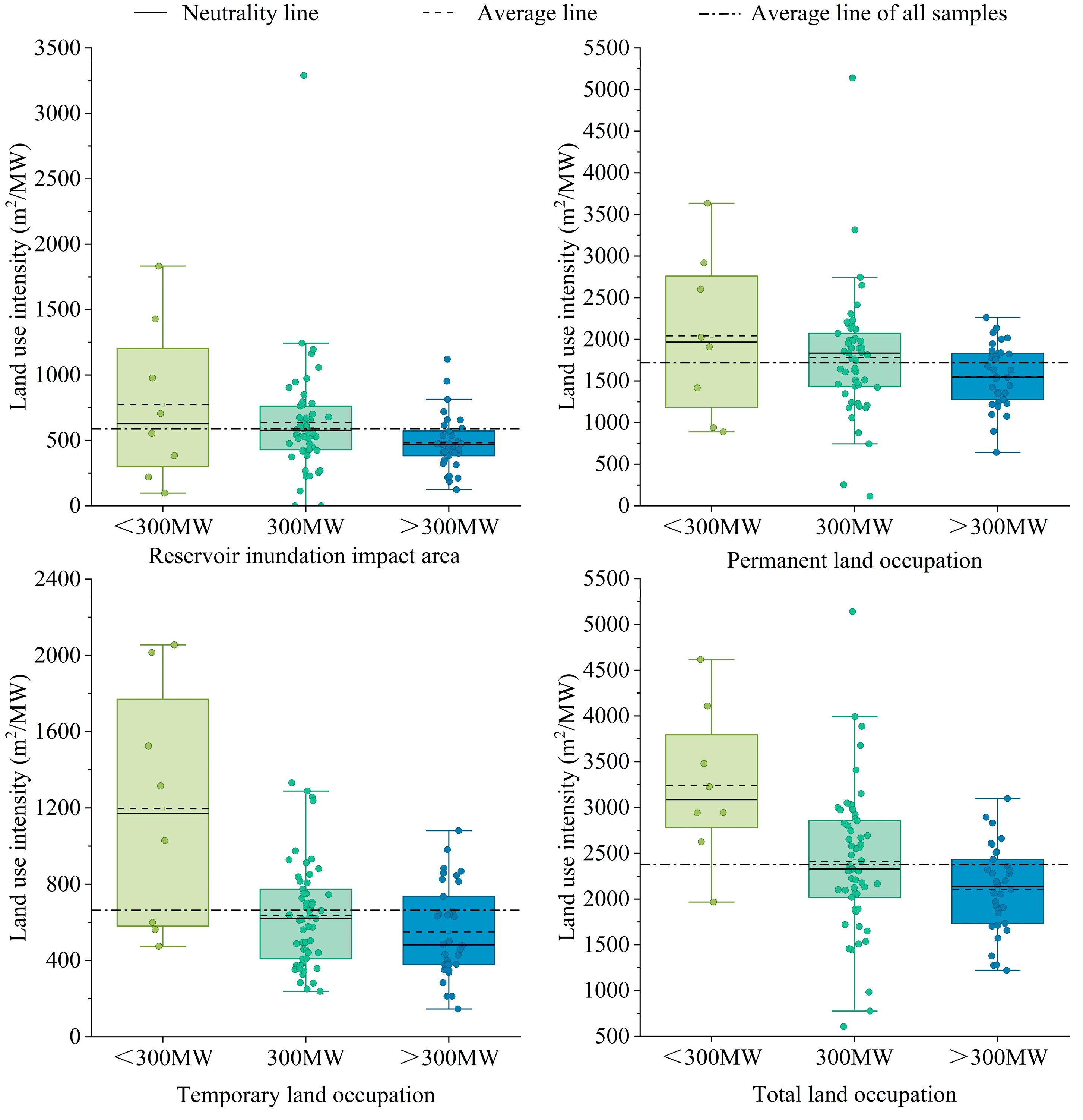Pumped Hydro Energy Storage Plants in China: Increasing Demand and Multidimensional Impacts Identification
Abstract
1. Introduction
2. The PHES Development in China
2.1. Development Trajectory of the PHES in China
2.1.1. Early Exploration of PHES
2.1.2. The Principal Option for Load Regulation of Power Systems
2.1.3. A Critical Component for Sustainable Energy Transition
2.2. Increasing Demand for PHES Construction in the Future
3. Multidimensional Impacts of PHES Development
3.1. Land Requirement and Related Ecological Concerns
3.2. Life-Cycle Environmental Impacts
3.3. Disturbances to Local Residents
4. Recommendations for Sustainable PHES Development
5. Conclusions
Supplementary Materials
Author Contributions
Funding
Data Availability Statement
Conflicts of Interest
References
- Chen, H.; Cong, T.N.; Yang, W.; Tan, C.; Li, Y.; Ding, Y. Progress in electrical energy storage system: A critical review. Prog. Nat. Sci. 2009, 19, 291–312. [Google Scholar]
- Kousksou, T.; Bruel, P.; Jamil, A.; El Rhafiki, T.; Zeraouli, Y. Energy storage: Applications and challenges. Sol. Energy Mater. Sol. Cells 2014, 120, 59–80. [Google Scholar]
- Wang, W.; Yuan, B.; Sun, Q.; Wennersten, R. Application of energy storage in integrated energy systems—A solution to fluctuation and uncertainty of renewable energy. J. Energy Storage 2022, 52, 104812. [Google Scholar]
- Amirante, R.; Cassone, E.; Distaso, E.; Tamburrano, P. Overview on recent developments in energy storage: Mechanical, electrochemical and hydrogen technologies. Energy Convers. Manag. 2017, 132, 372–387. [Google Scholar]
- Guney, M.; Tepe, Y. Classification and assessment of energy storage systems. Renew. Sustain. Energy Rev. 2017, 75, 1187–1197. [Google Scholar]
- Elalfy, D.A.; Gouda, E.; Kotb, M.F.; Bureš, V.; Sedhom, B.E. Comprehensive review of energy storage systems technologies, objectives, challenges, and future trends. Energy Strategy Rev. 2024, 54, 101482. [Google Scholar] [CrossRef]
- Rohit, A.K.; Devi, K.P.; Rangnekar, S. An overview of energy storage and its importance in Indian renewable energy sector: Part I–Technologies and Comparison. J. Energy Storage 2017, 13, 10–23. [Google Scholar]
- Zantye, M.S.; Gandhi, A.; Li, M.; Arora, A.; Sengalani, P.S.; Wang, Y.; Vudata, S.P.; Bhattacharyya, D.; Hasan, M.F. THESEUS: A techno-economic design, integration and downselection framework for energy storage. Energy Convers. Manag. 2023, 284, 116976. [Google Scholar]
- Li, J.; Zhao, Z.; Li, P.; Mahmud, M.A.; Liu, Y.; Chen, D.; Han, W. Comprehensive benefit evaluations for integrating off-river pumped hydro storage and floating photovoltaic. Energy Convers. Manag. 2023, 296, 117651. [Google Scholar]
- Mahlia, T.M.I.; Saktisahdan, T.J.; Jannifar, A.; Hasan, M.H.; Matseelar, H.S.C. A review of available methods and development on energy storage; technology update. Renew. Sustain. Energy Rev. 2014, 33, 532–545. [Google Scholar]
- Hameer, S.; van Niekerk, J.L. A review of large-scale electrical energy storage. Int. J. Energy Res. 2015, 39, 1179–1195. [Google Scholar] [CrossRef]
- Aneke, M.; Wang, M. Energy storage technologies and real life applications–A state of the art review. Appl. Energy 2016, 179, 350–377. [Google Scholar] [CrossRef]
- CESA (China Energy Storage Alliance). White Paper on Energy Storage Industry Research 2024; China Energy Storage Alliance: Beijing, China, 2024. (In Chinese) [Google Scholar]
- IHA. 2024 World Hydropower Outlook. 2024. Available online: https://acrobat.adobe.com/id/urn:aaid:sc:US:6ba5f8fc-5ad3-4d52-a83c-0931ce5fa119 (accessed on 5 December 2024).
- Gallo, A.B.; Simões-Moreira, J.R.; Costa, H.K.M.; Santos, M.M.; Dos Santos, E.M. Energy storage in the energy transition context: A technology review. Renew. Sustain. Energy Rev. 2016, 65, 800–822. [Google Scholar] [CrossRef]
- Vilanova, M.R.N.; Flores, A.T.; Balestieri, J.A.P. Pumped hydro storage plants: A review. J. Braz. Soc. Mech. Sci. Eng. 2020, 42, 415. [Google Scholar] [CrossRef]
- Yang, C.J.; Jackson, R.B. Opportunities and barriers to pumped-hydro energy storage in the United States. Renew. Sustain. Energy Rev. 2011, 15, 839–844. [Google Scholar] [CrossRef]
- IHA. 2018 Hydropower Status Report. 2018. Available online: https://hydropower-assets.s3.eu-west-2.amazonaws.com/publications-docs/iha_2018_hydropower_status_report_4.pdf (accessed on 5 December 2024).
- IHA. 2019 Hydropower Status Report. 2019. Available online: https://hydropower-assets.s3.eu-west-2.amazonaws.com/publications-docs/2019_hydropower_status_report_0.pdf (accessed on 5 December 2024).
- IHA. 2020 Hydropower Status Report. 2020. Available online: https://hydropower-assets.s3.eu-west-2.amazonaws.com/publications-docs/2020_hydropower_status_report.pdf (accessed on 5 December 2024).
- IHA. 2021 Hydropower Status Report. 2021. Available online: https://cdn.prod.website-files.com/64f9d0036cb97160cc26feba/64f9d0036cb97160cc2711ef_IHA20212405-status-report-02_LR.pdf (accessed on 5 December 2024).
- IHA. 2022 Hydropower Status Report. 2022. Available online: https://cdn.prod.website-files.com/64f9d0036cb97160cc26feba/64f9d0036cb97160cc2714ce_IHA202212-status-report-02.pdf (accessed on 5 December 2024).
- IHA. 2023 World Hydropower Outlook. 2023. Available online: https://indd.adobe.com/view/4201016f-a51a-4f6f-998b-ec85219d1dfd (accessed on 5 December 2024).
- NEA. National Renewable Power Development Monitoring and Evaluation Report 2023. 2024. Available online: https://zfxxgk.nea.gov.cn/2024-10/10/c_1310787115.htm (accessed on 5 December 2024). (In Chinese)
- Hussain, A.; Sarangi, G.K.; Pandit, A.; Ishaq, S.; Mamnun, N.; Ahmad, B.; Jamil, M.K. Hydropower development in the Hindu Kush Himalayan region: Issues, policies and opportunities. Renew. Sustain. Energy Rev. 2019, 107, 446–461. [Google Scholar] [CrossRef]
- Li, X.Z.; Chen, Z.J.; Fan, X.C.; Cheng, Z.J. Hydropower development situation and prospects in China. Renew. Sustain. Energy Rev. 2018, 82, 232–239. [Google Scholar] [CrossRef]
- Chen, R.; Li, J.; Pang, S. Discussion on the Diversification of Investment Entities in the Pumped Storage Industry. Energy China 2024, 45, 5–11. (In Chinese) [Google Scholar]
- Wen, Z.; Jiang, P.; Song, Z.; Li, L.; Jiang, Y.; Liang, T. Development status and progress of pumped storage in underground space of closed/abandoned mines. J. China Coal Soc. 2024, 49, 1358–1374. (In Chinese) [Google Scholar]
- Shi, L. The Ten—Year Journey and Achievements of the Autonomy of China’s Pumped—Storage Complete Sets of Equipment; China Electric Power Press: Beijing, China, 2017. (In Chinese) [Google Scholar]
- NEA. Medium- and Long-term Development Plan for Pumped Storage (2021–2035). 2021. Available online: https://zfxxgk.nea.gov.cn/1310193456_16318589869941n.pdf (accessed on 5 December 2024). (In Chinese)
- NEA. China’s Pumped Storage Installed Capacity Ranks First in the World. 2024. Available online: https://www.nea.gov.cn/2024-09/13/c_1310786100.htm (accessed on 5 December 2024). (In Chinese)
- IRENA. Renewable Energy Statistics 2024; International Renewable Energy Agency: Abu Dhabi, United Arab Emirates, 2024; Available online: https://www.irena.org/-/media/Files/IRENA/Agency/Publication/2024/Jul/IRENA_Renewable_Energy_Statistics_2024.pdf (accessed on 24 March 2025).
- IEA. Hydropower Data Explorer. 2024. Available online: https://www.iea.org/data-and-statistics/data-tools/hydropower-data-explorer (accessed on 5 December 2024).
- Gao, S.; Zhang, L.; Shi, X.; Wei, L. The Working Principle and Significance of the First Domestic Frequenency Converter for Pumped Storage Unit of Hundreds of Megawatts. Hydropower Pumped Storage 2017, 3, 43–49. (In Chinese) [Google Scholar]
- Ma, Z.; Wang, S.; Li, J. Site test on domestic startup frequency converter of Panjiakou Pumped Storage Units. Mech. Electr. Tech. Hydropower Stn. 2017, 40, 4–8. (In Chinese) [Google Scholar]
- Zhang, D.; Chen, T.; Li, Y. Survey on pumped storage power stations in Japan. South. Power Syst. Technol. 2009, 3, 1–5. [Google Scholar]
- CEC (China Electricity Council). China Electricity Yearbook; China Electric Power Press: Beijing, China, 2021. (In Chinese) [Google Scholar]
- NDRC; NEA. The 13th Five-Year Plan for Energy Development. 2016. Available online: https://www.nea.gov.cn/135989417_14846217874961n.pdf (accessed on 5 December 2024). (In Chinese)
- Kong, Y.; Kong, Z.; Liu, Z.; Wei, C.; Zhang, J.; An, G. Pumped storage power stations in China: The past, the present, and the future. Renew. Sustain. Energy Rev. 2017, 71, 720–731. [Google Scholar]
- Zhang, Y. Research on the price policy of pumping storage power under the target of “double carbon”—Take Yimeng pumping water storage power station project as an example. Price Theory Pract. 2021, 12, 392. (In Chinese) [Google Scholar]
- Song, Y.; He, H.; Yan, Y.; Zhai, L.; Yao, J.; Wu, B. A Toolbox for generalized pumped storage power station based on terrain in ArcGIS Environment. Renew. Energy 2024, 220, 119590. [Google Scholar]
- NDRC. Opinions of the National Development and Reform Commission on Further Improving the Price Formation Mechanism for Pumped Storage Energy. 2021. Available online: https://zfxxgk.ndrc.gov.cn/web/iteminfo.jsp?id=18085 (accessed on 24 March 2025). (In Chinese)
- Wang, Q.; Li, Y.; Zhang, Q.; Wang, D. A comparative analysis for various scaled mechanical energy storage technologies applied to power systems with a high share of renewable energy sources. Energy Storage Sci. Technol. 2024, 14, 854–867. (In Chinese) [Google Scholar]
- CREEI (China Renewable Energy Engineering Institute). Pumped Storage Industry Development Report. 2022; Water & Power Press: Beijing, China, 2023. (In Chinese) [Google Scholar]
- Li, J.; Chen, D.; Han, W.; Wang, P.; Zhao, Z.; Liu, G. Site identification and capacity determination of pumped hydro storage plants using GIS and spatial MCDM in Northwest China. Energy Convers. Manag. 2024, 322, 119179. [Google Scholar]
- Li, G.; Fang, C.; Wang, S. Exploring spatiotemporal changes in ecosystem-service values and hotspots in China. Sci. Total Environ. 2016, 545, 609–620. [Google Scholar] [CrossRef]
- Chen, W.; Yang, L.; Chi, G.; Zeng, J. Ecosystem degradation or restoration? The evolving role of land use in China, 2000–2020. Environ. Monit. Assess. 2024, 196, 304. [Google Scholar]
- Nzotcha, U.; Nsangou, J.C.; Kenfack, J.; Ngohe-Ekam, P.S.; Hamandjoda, O.; Bignom, B. Combining electric energy storage and deep-lake degassing by means of pumped hydropower. Appl. Energy 2021, 304, 117839. [Google Scholar]
- Lu, Z.; Gao, Y.; Zhao, W. A TODIM-based approach for environmental impact assessment of pumped hydro energy storage plant. J. Clean. Prod. 2020, 248, 119265. [Google Scholar]
- Oliveira, L.; Messagie, M.; Mertens, J.; Laget, H.; Coosemans, T.; Van Mierlo, J. Environmental performance of electricity storage systems for grid applications, a life cycle approach. Energy Convers. Manag. 2015, 101, 326–335. [Google Scholar]
- Kapila, S.; Oni, A.O.; Gemechu, E.D.; Kumar, A. Development of net energy ratios and life cycle greenhouse gas emissions of large-scale mechanical energy storage systems. Energy 2019, 170, 592–603. [Google Scholar] [CrossRef]
- Stougie, L.; Del Santo, G.; Innocenti, G.; Goosen, E.; Vermaas, D.; Van der Kooi, H.; Lombardi, L. Multi-dimensional life cycle assessment of decentralised energy storage systems. Energy 2019, 182, 535–543. [Google Scholar] [CrossRef]
- Guo, Z.; Ge, S.; Yao, X.; Li, H.; Li, X. Life cycle sustainability assessment of pumped hydro energy storage. Int. J. Energy Res. 2020, 44, 192–204. [Google Scholar]
- Denholm, P.; Kulcinski, G.L. Life cycle energy requirements and greenhouse gas emissions from large scale energy storage systems. Energy Convers. Manag. 2004, 45, 2153–2172. [Google Scholar] [CrossRef]
- Abdon, A.; Zhang, X.; Parra, D.; Patel, M.K.; Bauer, C.; Worlitschek, J. Techno-economic and environmental assessment of stationary electricity storage technologies for different time scales. Energy 2017, 139, 1173–1187. [Google Scholar]
- Wang, Q.; Chen, M.; Zhong, J. Market-Oriented Reform of Land Factor Allocation: Property Rights Foundation, Transfer Path and Revenue Distribution. China Land. Sci. 2021, 35, 109–118. (In Chinese) [Google Scholar]
- Nikolaos, P.C.; Marios, F.; Dimitris, K. A review of pumped hydro storage systems. Energies 2023, 16, 4516. [Google Scholar] [CrossRef]
- Wu, Y.; Zhang, T.; Xu, C.; Zhang, X.; Ke, Y.; Chu, H.; Xu, R. Location selection of seawater pumped hydro storage station in China based on multi-attribute decision making. Renew. Energy 2019, 139, 410–425. [Google Scholar]
- Javed, M.S.; Ma, T.; Jurasz, J.; Amin, M.Y. Solar and wind power generation systems with pumped hydro storage: Review and future perspectives. Renew. Energy 2020, 148, 176–192. [Google Scholar] [CrossRef]
- Zhang, J.; Cheng, C.; Yu, S.; Shen, J.; Wu, X.; Su, H. Preliminary feasibility analysis for remaking the function of cascade hydropower stations to enhance hydropower flexibility: A case study in China. Energy 2022, 260, 125163. [Google Scholar]




| Reference | Country | System Boundary | Functional Unit | Energy Mix | GHG Emissions (g CO2-eq/FU) | Main Conclusions |
|---|---|---|---|---|---|---|
| Denholm and Kulcinski [54] | USA | Cradle-to-grave | 1 GWh of delivered electricity | - | 5.6 | PHES has lower GHG emissions when combined with renewable energy than battery energy storage or CAES. |
| Oliveira et al. [50] | Switzerland | Cradle-to-grave | 1 kWh of delivered electricity | Belgium 2011 Electricity mix | About 230 | Sodium-sulfur batteries performed best, with pumped storage second. |
| Abdon et al. [55] | Switzerland | Cradle-to-grave | 1 kWh of delivered electricity | Swiss electricity grid mix | About 150–470 | PHES and adiabatic CAES show the best performance. |
| Kapila et al. [51] | USA | Cradle-to-grave | 1 kWh of delivered electricity | Canada average | 211.09 | PHES outperforms CAES, and GHG emissions are dominated by the operation stage. |
| Stougie et al. [52] | Norway | Cradle-to-grave | 10 kWh of storage capacity | Electricity, low voltage, production NL, at grid | 740,000 | The PHES system is preferred from an environmental sustainability point of view. |
| Guo et al. [53] | China | Cradle-to-grave | 1 kW | -- | Conventional PHES: 314,605 | CPHES has better performance in terms of economy and environment than UPHES. |
| Guo et al. [53] | China | Cradle-to-grave | 1 kW | -- | Underground PHES: 658,655 |
Disclaimer/Publisher’s Note: The statements, opinions and data contained in all publications are solely those of the individual author(s) and contributor(s) and not of MDPI and/or the editor(s). MDPI and/or the editor(s) disclaim responsibility for any injury to people or property resulting from any ideas, methods, instructions or products referred to in the content. |
© 2025 by the authors. Licensee MDPI, Basel, Switzerland. This article is an open access article distributed under the terms and conditions of the Creative Commons Attribution (CC BY) license (https://creativecommons.org/licenses/by/4.0/).
Share and Cite
Pang, M.; Du, Y.; Pei, W.; Zhang, P.; Yang, J.; Zhang, L. Pumped Hydro Energy Storage Plants in China: Increasing Demand and Multidimensional Impacts Identification. Energies 2025, 18, 1801. https://doi.org/10.3390/en18071801
Pang M, Du Y, Pei W, Zhang P, Yang J, Zhang L. Pumped Hydro Energy Storage Plants in China: Increasing Demand and Multidimensional Impacts Identification. Energies. 2025; 18(7):1801. https://doi.org/10.3390/en18071801
Chicago/Turabian StylePang, Mingyue, Yan Du, Wenjie Pei, Pengpeng Zhang, Juhua Yang, and Lixiao Zhang. 2025. "Pumped Hydro Energy Storage Plants in China: Increasing Demand and Multidimensional Impacts Identification" Energies 18, no. 7: 1801. https://doi.org/10.3390/en18071801
APA StylePang, M., Du, Y., Pei, W., Zhang, P., Yang, J., & Zhang, L. (2025). Pumped Hydro Energy Storage Plants in China: Increasing Demand and Multidimensional Impacts Identification. Energies, 18(7), 1801. https://doi.org/10.3390/en18071801







